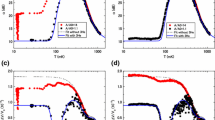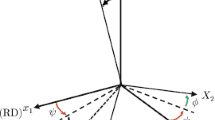Abstract
A report is given of the observation below 1 K of the sound attenuation δα expected from progressive orientational ordering in hcp H2 with ortho concentrationsX<0.53. The experiments were carried out at 10 and 30 MHz. The amplitude of this effect depends on the coupling between the lattice vibrations and the molecular orientation, and should be maximum when the acoustic angular frequency ω is comparable with the orientational relaxation rate τ−1. The average rate can be roughly estimated from NMR longitudinal relaxation timeT 1 measurements. Such a maximum for δα was indeed observed in the expected temperature range. At high enough temperatures, δα was found to be proportional toT −11 . which is consistent with predictions in the high temperature limit. Furthermore, the transition between the hcp and the fcc phases forX>0.53 is studied by means of the large changes in the sound propagation at the transition, and the phase diagram thus obtained is compared with results from x-ray and pressure measurements. The new observations explain some previous discrepancies in results using different methods. The difference between solid H2 and D2 regarding the stabilization of the cubic structure above the orientational ordering transition is also discussed. Calculations of the respective energy barriers ΔE to be overcome during the martensitic transition are suggested.
Similar content being viewed by others
References
I. F. Silvera,Rev. Mod. Phys. 52, 393 (1980).
J. Van Kranendonk,Solid Hydrogen (Plenum Press, New York, 1983.
A. B. Harris and H. Meyer,Can. J. Phys. 63, 3 (1985).
A. F. Schuch, R. L. Mills, and D. A. Depatie,Phys. Rev. 165, 1032 (1968).
J. F. Jarvis, H. Meyer, and D. Ramm,Phys. Rev. 178, 1461 (1969).
J. V. Gates, P. R. Ganfors, B. A. Fraas, and R. O. Simmons,Phys. Rev. B 19, 3667 (1979).
M. Clouter and H. P. Gush,Phys. Rev. Lett. 15, 200 (1965).
R. Wanner, H. Meyer, and R. L. Mills,J. Low Temp. Phys. 13, 337 (1973).
N. S. Sullivan, M. Devoret, B. P. Cowan, and C. Urbina,Phys. Rev. B 17, 5016 (1978).
C. A. Garland, inPhysical Acoustics, Vol. 7, W. P. Mason and R. V. Thurston, eds. (Academic Press, New York, 1970), p. 51.
B. Luthi, T. J. Moran, and R. J. Pollina,J. Phys. Chem. Solids 31, 1741 (1970).
K. Kawasaki,Int. J. Magnetism 1, 171 (1971).
S. Washburn, M. Calkins, H. Meyer, and A. B. Harris,J. Low Temp. Phys. 53, 585 (1983).
N. S. Sullivan and D. Esteve,Physica 107(B+C), 189 (1981).
J. R. Gaines, Y. C. Shi, and J. H. Constable,Phys. Rev. B 17, 1028 (1978).
A. B. Harris,Phys. Rev. B 2, 3495 (1970).
M. Fujio, J. Hama, and T. Nakamura,Prog. Theor. Phys. 54, 293 (1975).
G. W. Smith and R. M. Housley,Phys. Rev. 117, 732 (1960).
L. I. Amstutz, H. Meyer, S. M. Myers, and D. C. Rorer,Phys. Rev. 181, 589 (1969).
J. L. Yarnell, R. L. Mills, and A. F. Schuch,Sov. J. Low Temp. Phys. 1, 366 (1975).
D. G. Haase, J. O. Sears, and R. A. Orban,Solid State Commun. 35, 891 (1980).
R. W. Hill and B. W. A. Ricketson,Phil. Mag. 45, 277 (1954).
G. Ahlers and W. H. Orttung,Phys. Rev. 133A, 1642 (1964).
A. B. Harris, S. Washburn, and H. Meyer,J. Low Temp. Phys. 50, 151 (1983).
R. Wanner and H. Meyer,J. Low Temp. Phys. 11, 715 (1973).
M. Calkins and H. Meyer,J. Low Temp. Phys. 57, 265 (1964).
B. Golding,Phys. Rev. Lett. 84, 1102 (1975).
H. Nagai and T. Nakamura,Prog. Theor. Phys. 37, 641 (1967).
J. Felsteiner,Phys. Rev. Lett. 15, 1025 (1965).
J. C. Raich and R. D. Etters,J. Phys. Chem. Solids 29, 1561 (1968).
L. H. Nosanow, cited in Ref. 30.
Author information
Authors and Affiliations
Rights and permissions
About this article
Cite this article
Banke, R., Calkins, M. & Meyer, H. Ultrasonic propagation in solid H2: The effects of orientational ordering. J Low Temp Phys 61, 193–211 (1985). https://doi.org/10.1007/BF00681631
Received:
Issue Date:
DOI: https://doi.org/10.1007/BF00681631




